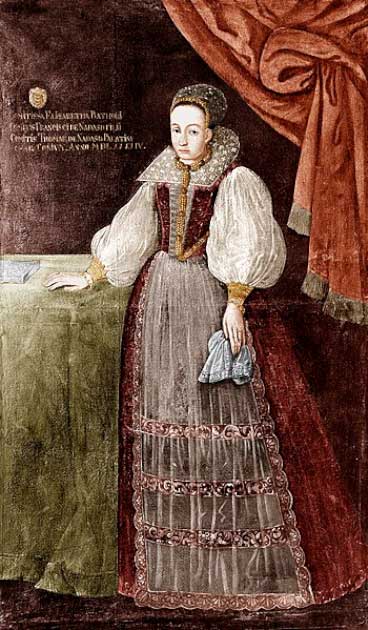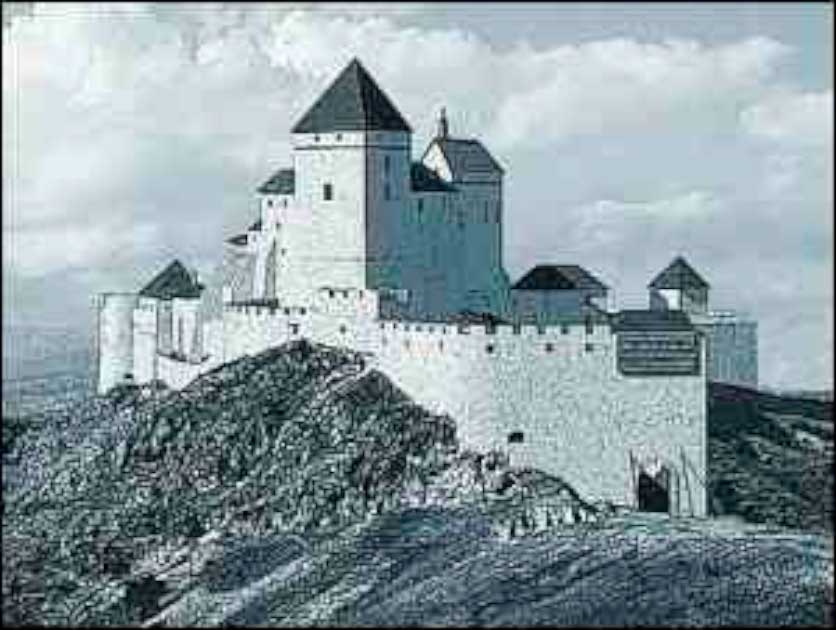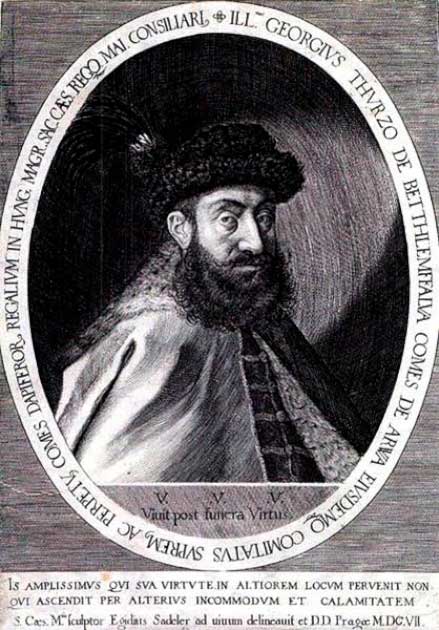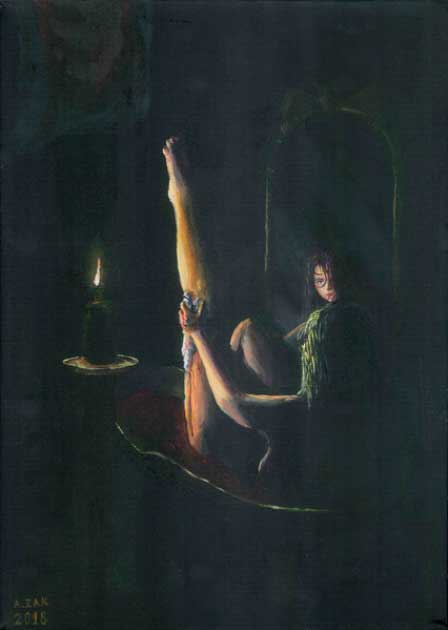If the rumors of her life were true, Elizabeth Báthory, known as The Blood Countess of Hungary was the most prolific female serial killer in history. Supposedly responsible for the deaths of 650 girls, a tally which led her to be included in the Guinness Book of Records, she would bathe in and drink the blood of her servants and peasants to make her younger.
Many suspect she may have been more than human, and so bloodthirsty was her wrath that she became the inspiration for Bram Stoker’s Dracula. The methods of torture she used make the torture devices and practices of the Spanish Inquisition look like a day at the spa.
But was she a vampire? And, in truth, was she guilty of all these crimes? It is time to meet the Blood Countess of Hungary.
Erzsébet Báthori- Elizabeth Báthory
Countess Elizabeth Báthory, (Erzsébet Báthori in Hungarian), was born in 1560 in Nyírbátor in Royal Hungary. The Countess came from a very influential family. Her parents were both Báthory, her father was Baron George VI Báthory of the Ecsed branch of the Báthory family and her mother was Baroness Anna Báthory.
Two of her uncles were the voivodes of Transylvania. A voivode was the highest-ranking government official of Transylvania in the Kingdom of Hungary, a military leader and effectively a warlord. The most notable relative however was her uncle Stephen Báthory: King of Poland, the Grand Duke of Lithuania of the Polish-Lithuanian Commonwealth, and the Prince of Transylvania.
Elizabeth was wealthy, beautiful, and educated. She could read and write, and spoke several different languages. The one imperfect thing about her perfect life was Elizabeth had seizures as a child. Many suggest that her parents inbreeding caused their child to suffer from the “falling sickness” (epilepsy).

Standard treatment for falling sickness in the 16th century was consuming or rubbing the blood of someone who didn’t have the illness on the patient. Her thirst for blood, it would seem, began at an early age.
An Early Engagement and a Match From Hell
At the age of 11 or 12, Elizabeth Báthory became engaged to Count Ferenc Nádasdy, who she married at the age of 15 in 1575. This marriage was likely arranged for political purposes. As a wedding gift from her new husband, the ownership of a castle was given to Elizabeth.
Castle Csejte was located in present-day Slovakia and came with a summer house and dominion over 17 local villages. However again there were strange features of this gift: to please his new wife, Nádasdy was said to have built a torture chamber at the castle. Elizabeth had apparently specifically requested it.
Count Ferenc was a notable soldier, rumored to be cruel to servants and prisoners. He had a hobby of “throwing Turkish prisoners into the air and catching them with his sword, impaling them.” It was legal to discipline servants physically because “nobody would miss them.”
This gave the couple free reign to apparently torture their staff. Ferenc may even have been the one who taught her about torture and murder, and it is believed that the couple indulged this sadism together.
- Not Quite Human? Bela Kiss, The Hungarian Vampire
- Queen Ranavalona I: Most Murderous Woman in History
In 1575, Count Ferenc became the chief commander of the Hungarian army and left Elisabeth Báthory alone while he fought against the Ottomans. In his absence, Countess Elizabeth Báthory managed his affairs and was responsible for the peasants in the 17 villages that came with Castle Csejte.

Although away for long periods, it seems that the marriage was somewhat successful, lasting until 1604 and with at least three children. However, after around 30 years of marriage Count Ferenc Nádasdy died due to illness. Many believe Báthory may have poisoned him and, in the wake of her husband’s death, Countess Báthory’s torture hobby became a full-fledged addiction.
The Blood Countess is Born
With the aid of a dwarf, the wetnurse of her children, two witches, and her closest confidant (and possible lover) Anna Darvulia, Elizabeth started to become worryingly obsessed with torture and murder. Girls in the local villages began to disappear, never to return. Her five associates were known to kidnap children to bring to the countess.
Elizabeth Báthory is known as the Blood Countess after word spread about her unique routine of bathing in the blood of virgin girls. With a desire to be younger, Elizabeth Báthory frequently would have girls killed or exsanguinated after torture in a bathtub.
She would later bathe in the blood, earning her the name The Blood Countess. Castle Csejte began offering jobs to young peasant girls who went to work for the Blood Countess, but after a few disappearances it became clear that this was dangerous work indeed.
However, after a time Elizabeth noticed that she was ageing and concluded that the servants’ blood wasn’t working like it used to. It must have been because they were poor, she reasoned; their blood was no longer suitable.
What the Blood Countess did to access “better” blood was to create a gynaeceum. A gynaeceum was a school where young girls of the lesser gentry were sent to learn “courtly etiquette.”
However, here she made a fatal error. Had the Blood Countess kept killing peasant girls, it is possible she could have continued her cruelty undetected. However, using the gynaeceum to kill women of a higher social standing led to the investigation of the century.
The Long Hand of The Law
In December 1610, the Palatine of Hungary (the top judge under the king) György Thurzó was sent to investigate Castle Csejte. György began gathering statements from witnesses about the cruelty of Elizabeth Báthory, almost 300 statements in total. Armed with this testimony, György Thurzó raided the castle one night and walked in on the Countess torturing a young girl.

Caught with blood on her hands, the Blood Countess and her now four accomplices (Darvulia was dead) were taken to trial. A servant testified that she saw a castle document listing her victim count as 650.
Her four co-conspirators were to be executed. The wetnurse and the two witches were burned alive, and because the dwarf was so young, he was beheaded as a less “adult way of execution.”
Due to her social rank, Elizabeth did not attend her trial and was sentenced to house arrest in her castle, locked in a windowless room. Her accomplices were executed, and in 1614, The Blood Countess died.
The list of crimes was extensive. It was said that the Countess would torture the girls by beating them to death, biting chunks out of their faces and breasts. She stabbed and cut the girls with scissors, burned the faces and genitals of girls with a hot iron, and starved those who survived.
More of her torture methods included covering girls in honey and, leaving them outside, locking nude girls outside in winter. She would hook two fingers into the girls’ mouths and pulled until their lips and cheeks split, and was also said to have made a girl cut off her breast, cook it, and eat it.
Rumors, Myths, and Legends
Too gruesome to be true? It is certainly possible that the stories were exaggerated or wholly fabricated, and many historians have dismissed the crimes and bloody rituals as myths from the past that remain today. Most of Elizabeth’s story is thought to be largely embellished, and a lot of false information about the countess was spread and can be refuted.
None of the dramatic claims about torture or blood-drinking have been proven true. They are seen as rumors and book content writers added to spice up their horror stories about her. Her friends confessed under torture and likely gave false confessions, using the countess as a scapegoat.

Epidemics were rampant in the 15th and early 16th centuries. As a royal, killing servants would be foolish because due to illnesses and death, she would be short-staffed and have to do work on her own. Historic documents showed that many girls had died from plague and typhus; all the deaths were recorded in the castle’s records.
Members of the lower gentry would not have sent their girls to her gynaeceum if they believed she was killing people. Anna Darvulia wasn’t a “witch” at all but rather a healer who “specialized” in bloodletting, cauterizing wounds with hot irons, and surgical procedures like removing tumors. Elizabeth was fascinated by medicine and healers, and with sick girls at her castle, would have wanted a healer like Darvulia.
The trial and accusations may have been a political scandal. The Báthory and Nádasdy families had control of a lot of land, castles, and control. Tarnishing the names of the two families would have led them to lose everything.
Furthermore, the king of Hungary owed Elizabeth a large sum of money. He didn’t need to repay the countess if she was locked away or dead. Thurzó was sent by the king to “investigate”; if she were out of the way, her land and money would go to them. Elizabeth, a powerful woman outside of the control of men, may also have been seen as a threat to the powers that be.
Even her vampiric tendencies are somewhat uncertain. Consuming blood to treat epilepsy dates back to ancient Greece. The blood of gladiators was given to epileptic people along with ground skulls or eating the flesh of a newly dead person. Her drinking or smearing blood on her after a seizure was standard medical treatment and not a sign of vampirism.
The rumors of blood bathing came from one author’s claims, 100 years after Elizabeth died. It is unlikely she did any blood bathing because it would take the blood of over thirty adults to fill a tub. In reality, Elizabeth Báthory was a countess who was blamed for things she didn’t do and had to suffer the consequences.
Was she innocent? It cannot be said. Was she a victim? It would seem likely that, in part, she was.
Top Image: Was Elizabeth Báthory an evil serial killer or was she the victim of trumped up charges? Source: Fernando Cortés / Adobe Stock.
By Lauren Dillon